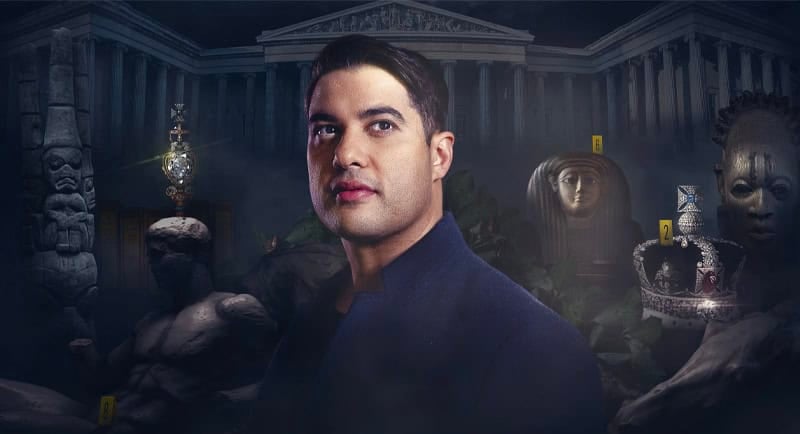Museums and galleries are filled with artworks, jewels, and priceless relics that have been seized and taken halfway across the planet for display. Following the success of the show’s first season, Marc Fennell returns with a new season of Stuff The British Stole on ABC and iView.
In this season, Fennell wanders from Egyptian deserts to deep in the Amazon River and takes viewers from a shipwreck in the depths of the Aegean Sea to a robot laboratory high in a Tuscan mountain range. Kicking off the season, Stephen Fry joins Fennell for an investigation into what could be the most controversial museum display in Britain, the Parthenon Marbles.
Ahead of the new season airing, Mediaweek caught up with Fennell to speak about filming season two, and the success of the Stuff The British Stole podcast.
You filmed across 11 different countries, what’s it like working to that sort of filming schedule?
All told it was 11 countries in five months, and I crushed my ankle in Egypt so I ended up having to do most of it limping. Because I’m directing most of the show, you fall into a zone where you’re in work mode, you’re constantly moving or planning or thinking about the next day or looking at the footage from the day before. But I’d have occasionally these weird out-of-body experiences like, I can’t believe I’m standing on the top of the mountain made out of marble in Tuscany.
I’ve joked for a long time that this show is Indiana Jones in reverse – he goes around the world and says things belong in a museum, and then I come along and go, yeah, but does it? But the job of filming it genuinely does feel like an amazing adventure.
I can only imagine a show like this would be full of pinch-me moments.
You have to acknowledge the privilege of it, right? The responsibility is to try and bottle this sense of adventure and capture that energy for an audience, so when they’re at home watching on iView, or on Monday night, they feel the same way we feel about it as we’re doing it.
How do you go about bottling that feeling?
It’s always remembering that it’s a mystery show first. We set up an email address when we started the podcast so that people could email us with anything in a museum or gallery they were curious about. We’ve had literally thousands of emails. From that, we would narrow it down. What I’m looking for is an object that is intriguing in and of itself, but opens up a doorway into history. It’s really important to preserve that sense of discovery.
If an object’s got a clear-cut history – it was clearly taken by this person at that time – it’s not as interesting as something with multiple points of view. Maybe it was taken, maybe it wasn’t. The thing that excites me about the show is the grey areas of history, where it’s not instantly obvious whether something was good or bad, and it’s about bringing the audience along for the ride of the mystery so that they can decide whether something was good, bad, or a bit of both.
Can you tell me a bit about how the show and the podcast differ?
I view them all as part of the same universe of stories, I don’t think of one as higher or lower than the other. They’re connected, but there are some crucial differences.
With the television show, you have to be able to show people things, and the one piece of leverage that museums and galleries have is they can always say no, you can’t film the object and we won’t answer any questions. I suspect they think that will stop the stories from going ahead, and it doesn’t.
With the television show, we have a whole budget just for replicates. Now, if we use a replica in the show we always tell you at some point, but we had a whole replica of a sphinx made for, we had to replicate a sixth-century mosaic, we borrowed the crown from one of the props companies that does the props for The Crown. We’re always trying to bring things to life.
The podcast just hit 5 million downloads last month, which is huge – congratulations.
Thank you. The reason I’m surprised by it is because you have to consider the origin of this thing – it literally started with me and a microphone by myself with a couple of hours to spare in London. We’d had the idea and I’d pitched it around to British broadcasters at the time. This is 2019 and all these British broadcasters just looked at me blankly like, Did we really steal that much stuff, though?
I just started recording it by myself with the microphone. From then the ABC and CBC got involved, and when the podcast launched it went to number one in a whole bunch of different online podcasts rankers. I was like, What? I thought I thought I was making this weird niche show about nicked artefacts, and actually, I think it tapped into something that I don’t think I could have predicted.
Finally – is your ankle okay now?
I was at the gym, and my trainer was asked if my ankle was still a bit wonky. I didn’t really have time to get it looked at because we were filming from May all the way up to October, and by the time it was done and I had it out of my head, I had sort of forgotten that my ankle had ever felt any different. So the short version is no, it’s not totally better, and yes, I should seek professional help. Or I’ll just focus on upper-body workouts for the rest of my life.
Stuff The British Stole season two airs Monday nights at 8pm ABC TV and any time on ABC iview
